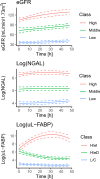Trajectory pattern of serially measured acute kidney injury biomarkers in critically ill patients: a prospective observational study
- PMID: 38842613
- PMCID: PMC11156822
- DOI: 10.1186/s13613-024-01328-9
Trajectory pattern of serially measured acute kidney injury biomarkers in critically ill patients: a prospective observational study
Abstract
Background: The clinical value of the trajectory of temporal changes in acute kidney injury (AKI) biomarkers has not been well established among intensive care unit (ICU) patients.
Methods: This is a single-center, prospective observational study, performed at a mixed ICU in a teaching medical institute in Tokyo, Japan. Adult ICU patients with an arterial line and urethral catheter were enrolled from September 2014 to March 2015. Patients who stayed in the ICU for less than 48 h and patients with known end-stage renal disease were excluded from the study. Blood and urine samples were collected for measurement of AKI biomarkers at 0, 12, 24, and 48 h after ICU admission. The primary outcome was major adverse kidney events (MAKE) at discharge, defined as a composite of death, dialysis dependency, and persistent loss of kidney function (≥ 25% decline in eGFR).
Results: The study included 156 patients. Serum creatinine-based estimated glomerular filtration rate (eGFR), plasma neutrophil gelatinase-associated lipocalin (NGAL), and urinary liver-type fatty acid-binding protein (uL-FABP) were serially measured and each variable was classified into three groups based on group-based trajectory modeling analysis. While the trajectory curves moved parallel to each other (i.e., "low," "middle," and "high") for eGFR and plasma NGAL, the uL-FABP curves showed distinct trajectory patterns and moved in different directions ("low and constant," "high and exponential decrease," and "high and exponential increase"). These trajectory patterns were significantly associated with MAKE. MAKE occurred in 16 (18%), 16 (40%), and 9 (100%) patients in the "low and constant," "high and exponential decrease," and "high and exponential increase" groups, respectively, based on uL-FABP levels (p-value < 0.001). The initial value and the 12-h change in uL-FABP were both significantly associated with MAKE, even after adjusting for eGFR [Odds ratio (95% confidence interval): 1.45 (1.17-1.83) and 1.43 (1.12-1.88) for increase of initial value and 12-h change of log-transformed uL-FABP by 1 point, respectively].
Conclusions: Trajectory pattern of serially measured urinary L-FABP was significantly associated with MAKE in ICU patients.
Keywords: Acute kidney injury; Biomarker; Group-based trajectory modeling; Liver-type fatty acid-binding protein; Major adverse kidney event; Neutrophil gelatinase-associated lipocalin; Trajectory.
© 2024. The Author(s).
Conflict of interest statement
The authors have no conflicts of interest to declare.
Figures



References
LinkOut - more resources
Full Text Sources
Research Materials
Miscellaneous

